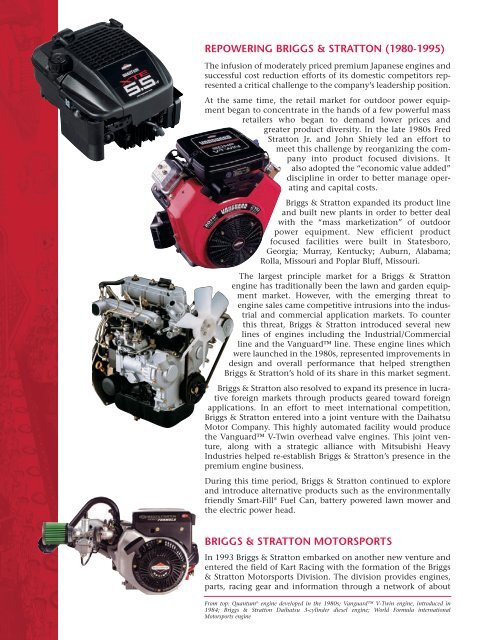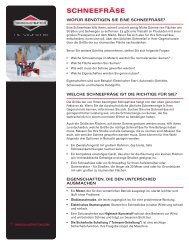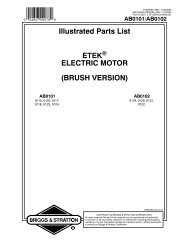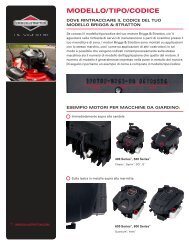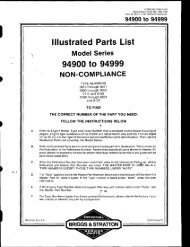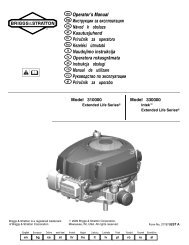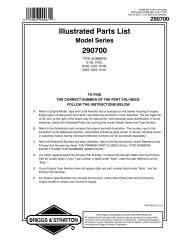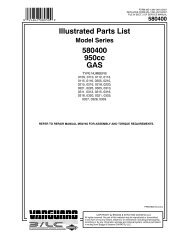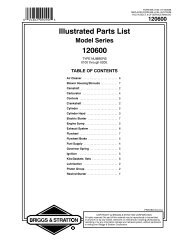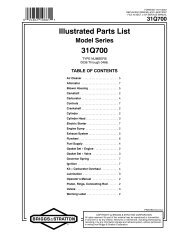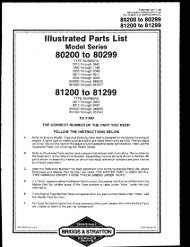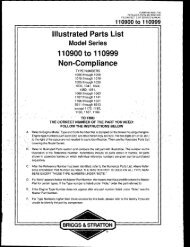The History of Briggs & Stratton
The History of Briggs & Stratton
The History of Briggs & Stratton
Create successful ePaper yourself
Turn your PDF publications into a flip-book with our unique Google optimized e-Paper software.
REPOWERING BRIGGS & STRATTON (1980-1995)<strong>The</strong> infusion <strong>of</strong> moderately priced premium Japanese engines andsuccessful cost reduction efforts <strong>of</strong> its domestic competitors representeda critical challenge to the company’s leadership position.At the same time, the retail market for outdoor power equipmentbegan to concentrate in the hands <strong>of</strong> a few powerful massretailers who began to demand lower prices andgreater product diversity. In the late 1980s Fred<strong>Stratton</strong> Jr. and John Shiely led an effort tomeet this challenge by reorganizing the companyinto product focused divisions. Italso adopted the “economic value added”discipline in order to better manage operatingand capital costs.<strong>Briggs</strong> & <strong>Stratton</strong> expanded its product lineand built new plants in order to better dealwith the “mass marketization” <strong>of</strong> outdoorpower equipment. New efficient productfocused facilities were built in Statesboro,Georgia; Murray, Kentucky; Auburn, Alabama;Rolla, Missouri and Poplar Bluff, Missouri.<strong>The</strong> largest principle market for a <strong>Briggs</strong> & <strong>Stratton</strong>engine has traditionally been the lawn and garden equipmentmarket. However, with the emerging threat toengine sales came competitive intrusions into the industrialand commercial application markets. To counterthis threat, <strong>Briggs</strong> & <strong>Stratton</strong> introduced several newlines <strong>of</strong> engines including the Industrial/Commercialline and the Vanguard line. <strong>The</strong>se engine lines whichwere launched in the 1980s, represented improvements indesign and overall performance that helped strengthen<strong>Briggs</strong> & <strong>Stratton</strong>’s hold <strong>of</strong> its share in this market segment.<strong>Briggs</strong> & <strong>Stratton</strong> also resolved to expand its presence in lucrativeforeign markets through products geared toward foreignapplications. In an effort to meet international competition,<strong>Briggs</strong> & <strong>Stratton</strong> entered into a joint venture with the DaihatsuMotor Company. This highly automated facility would producethe Vanguard V-Twin overhead valve engines. This joint venture,along with a strategic alliance with Mitsubishi HeavyIndustries helped re-establish <strong>Briggs</strong> & <strong>Stratton</strong>’s presence in thepremium engine business.During this time period, <strong>Briggs</strong> & <strong>Stratton</strong> continued to exploreand introduce alternative products such as the environmentallyfriendly Smart-Fill ® Fuel Can, battery powered lawn mower andthe electric power head.BRIGGS & STRATTON MOTORSPORTSIn 1993 <strong>Briggs</strong> & <strong>Stratton</strong> embarked on another new venture andentered the field <strong>of</strong> Kart Racing with the formation <strong>of</strong> the <strong>Briggs</strong>& <strong>Stratton</strong> Motorsports Division. <strong>The</strong> division provides engines,parts, racing gear and information through a network <strong>of</strong> aboutFrom top: Quantum ® engine developed in the 1980s; Vanguard V-Twin engine, introduced in1984; <strong>Briggs</strong> & <strong>Stratton</strong> Daihatsu 3-cylinder diesel engine; World Formula internationalMotorsports engine


